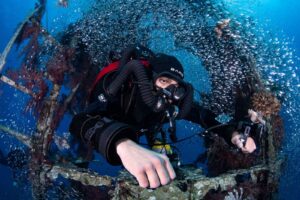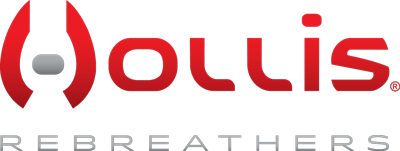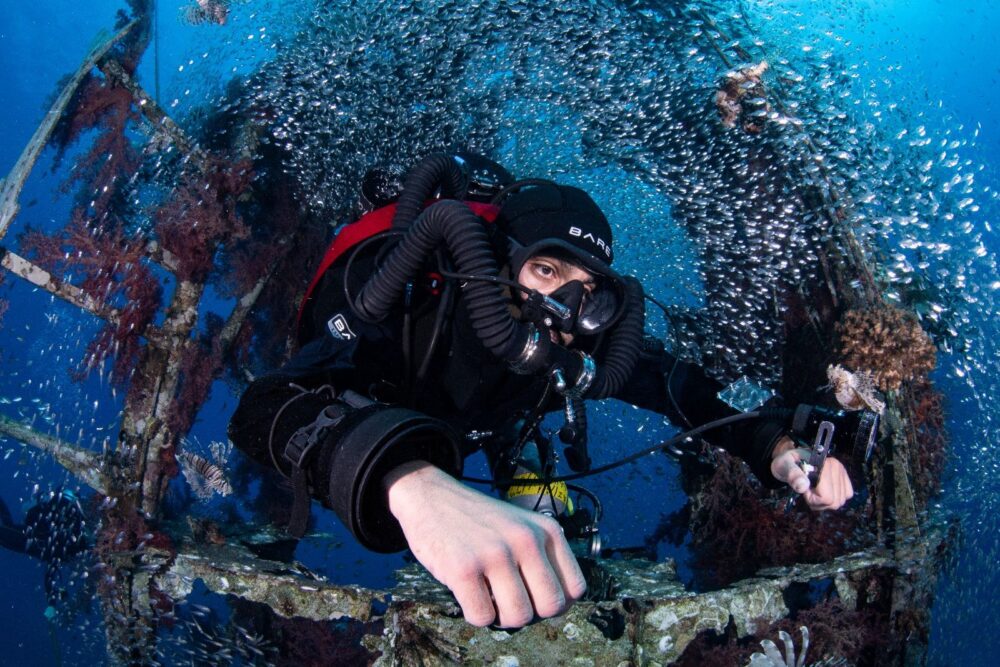
Like it or not, recreational scuba diving has its limits. While great for making brief visits to our underwater ecosystems, a typical scuba rig—even with nitrox—can only provide so much bottom time. For most of us, that’s okay, because the duration of a typical dive doesn’t usually need to be that long. But what about folks that need to stay down longer?
For example, many industrial divers and scientific researchers require long, uninterrupted dive times spent welding, surveying or collecting data. So when the typical scuba rig (even with an extra gas tank) isn’t enough, underwater pros turn to a rebreather—such as the Hollis Rebreather Prism 2—to increase the amount of time they can spend underwater.
Allison Shafer, Dive Officer at the California Academy of Sciences, says that the Prism 2 is essential to her team’s work because it guarantees longer dive times and a huge range of depth.
“As a scientist, the last thing you want to be doing is rushing your data, because your safety on a dive is always your top priority,” she explains. “Longer dive times let you get more work done. We’re not just down there cruising around looking at scenery. You have objectives. So, the less you have to worry about your exact gas consumption and depth, the higher quality your data is going to be.”
Cal Academy has two dive teams working on research all across the globe, and both use the Prism 2. For the past five years, the Academy’s Mesophotic Fish Team has been traveling to Hawaii, Tahiti, Zanzibar and other tropical locales to study mesophotic range. Shafer explains that, while some of these sites are accessible with open circuit, it doesn’t give you a lot of working time to gather data and make observations.
The Mesophotic Fish Team recently tested the Refugio Theory, which suggests that these deeper reefs might be a refuge for shallow-reef fish species. Shallower reefs have been heavily impacted by overfishing and climate change, so the researchers wanted to see if fish are seeking shelter in these deeper reefs. After conducting numerous P2 dives, the Mesophotic team discovered that the Refugio Theory is not correct.
“It wasn’t really true,” Shafer says. We found that they have unique communities down there that deal with their own stresses, many the same ones as the shallow reefs are dealing with. It was kind of a bummer—but nonetheless, a cool discovery.”
Greg Asner, the Director of ASU’s Center for Global Discovery and Conservation Sciences, also uses the Prism 2 in the field for research. As a crusader against climate change, coral bleaching and ocean acidification, Asner spearheads a crowdsourcing effort to report bleaching events across the state of Hawaii.
After partnering with the State of Hawaii and other non-profit and federal agencies, they created Hawaiicoral.org for people to report bleaching in real time. In essence, the site’s goal is to get divers and snorkelers to report highly impacted areas so that Asner and his team can go study the reefs that are increasingly under stress.
Once the ASU team has a site to study, they inevitably spend a lot of time in the water doing field work. Much of this diving is enhanced greatly through the use of Prism 2. The Prism 2 opens up bottom times and depth ranges that they can’t achieve any other way. This allows long-duration coral reef surveys that enable the kind of science and reporting that’s needed to save coral reefs and develop new marine-protected areas.
Another prominent explorer and researcher putting the Prism 2 through its paces is writer and cave diver Jill Heinerth. With her recently released memoir, Into the Planet, Heinerth discusses her evolution as a diver and instructor, but also recounts many of the amazing exploits she’s undertaken with the Prism 2.
Heinerth’s exploratory challenges mandate that her equipment allow her to dive deep into cave systems without worrying about her oxygen supply. Able to recirculate air for hours and hours, Jill can use the P2 to penetrate underwater caverns at depths and distances that would be impossible without a rebreather system. Simply put, Prism 2 allows Jill to push the boundaries of human understanding and exploration and far exceed the accomplishment of those that came before.
“For me, the P2 is a tool,” Heinerth says. “Sometimes I choose it for range [deep or far inside a cave] and other times, I choose it because it helps me minimize my impact on the caves.”
In some cases—as mentioned above—Heinerth and her teams are trying to maintain stable water chemistry or prevent silting caused by percolation from the cave ceiling. Rebreathers help limit these disturbances because they don’t emit bubbles like traditional scuba rigs do.
“There are some caves with very rare stygobitic animals that we are trying to conserve,” she continues. “Other divers use rebreathers to improve their interaction with wildlife. As a rebreather diver, we are less likely to frighten away marine life with the sound of bubbles.”
While it may be tough to travel and do field research in the current era of the Covid-19 pandemic, Heinerth also stands by the Prism 2 because it’s so conducive to getting to the next project. Calling the P2 ‘simple,’ the explorer says that part of what makes the Prism 2 a shoe-in for her research and exploration is its ability to survive and thrive in the field.
“The P2 works really well for me,” Heinerth concludes. “It is simple and easy to repair in the field. It travels well—and it’s robust and light enough to fit into tight luggage limits.”


